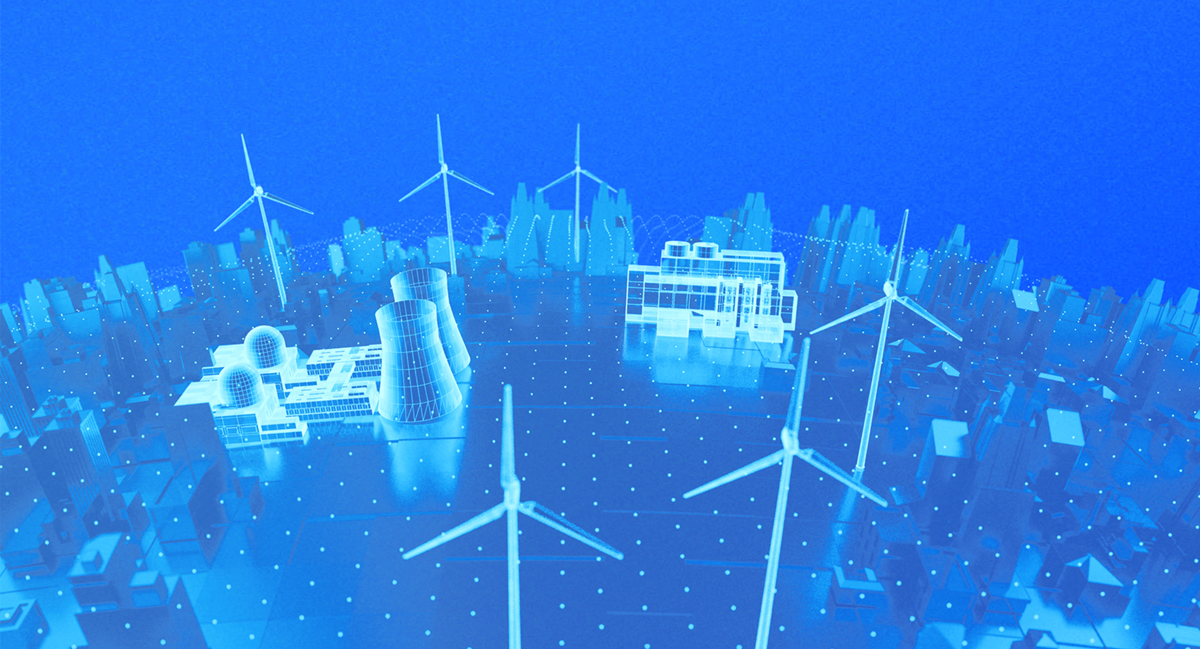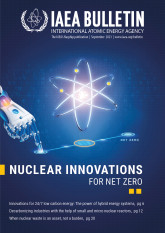
If you would like to learn more about the IAEA’s work, sign up for our weekly updates containing our most important news, multimedia and more.
Innovations for 24/7 Low Carbon Energy: The Power of Hybrid Energy Systems
Emma Midgley

Integrated energy systems have the potential to ensure consistent grid demand fulfilment, regardless of whether power generation comes from nuclear or renewable sources. (Image: IAEA)
The deployment of all low carbon energy sources is key to reducing emissions from the energy sector. As the share of intermittent renewable systems has increased in power grids to ensure a supply of low carbon energy 24/7, nuclear power plants are being used in hybrid energy systems (HESs) to fill in the gaps left by solar and wind electricity production.
Nuclear power is a dispatchable source of energy generation, able to adjust to changing energy demand, and it can generate enormous amounts of reliable, low carbon electricity around the clock. This stability is the reason why nuclear power has typically been used as baseload — operating continuously with little, if any, variation in output. Together with renewables, nuclear power also contributes to the stability of electricity grids by backing up the intermittent output of renewable sources. For example, some nuclear power plants in the United States of America regularly adjust capacity by around 10 to 15 per cent to reflect common variations in electricity demand and the intermittent contribution of renewables.
“Nuclear-renewable HESs offer a powerful synergy, combining the reliability and baseload capacity of nuclear power with intermittent renewable sources. This integrated approach holds the key to a resilient, low carbon energy future that can meet growing demand while mitigating climate change,” said Tatjana Jevremovic, IAEA Team Leader for Water Reactor Technology Development.
In order to decarbonize every hour of energy consumption, all carbon-free technologies will need to be utilized. The potential of synergies among these energy resources is still to be fully exploited, and experts are investigating the strategic advantages of directly integrating these system alternatives. Nuclear–renewable HESs seek to couple nuclear and renewable energy sources by leveraging each of their benefits. The goal is to supply the grid with dependable and sustainable electricity, while simultaneously offering low carbon energy to various sectors of energy consumption.
Nuclear-renewable HESs offer a powerful synergy, combining the reliability and baseload capacity of nuclear power with intermittent renewable sources.
Coupled systems
Hybrid systems incorporate multiple energy generators in two distinct ways. The first is through loosely coupled systems, which combine the output of various energy sources to enhance overall system performance and reliability. The second — yet to be realized for nuclear–renewable HESs — is through a more integrated, tightly coupled system. This type of system leverages the unique strengths of each component to achieve optimized energy production and environmental benefits.
“A transition towards more integrated energy systems holds the potential to ensure consistent grid demand fulfilment, regardless of whether power generation comes from nuclear, wind, hydro, solar, biomass or geothermal sources. Ideally, such systems would also incorporate energy storage solutions to effectively manage fluctuations in net power demands,” Jevremovic said. “In addition, the inclusion of carbon taxes in the economic assessment of adopting nuclear–renewable HESs could potentially render their operational costs even lower than those associated with conventional fossil fuel energy sources.”
In the future, tightly coupled HESs would be engineered to maximize synergy and optimize power generation based on real-time conditions. For example, renewable sources could be more greatly integrated with nuclear power plants to provide supplemental power during peak demand, compensating for nuclear power’s inflexibility to change output quickly. In another example, if nuclear power were to be integrated with hydroelectric systems, excess energy from nuclear reactors during off-peak hours could be used to pump water into elevated reservoirs, which could later be released to drive hydropower turbines during periods of high demand.
Nuclear–renewable HESs could also be used to manage and coordinate electricity generation in remote or off-grid locations to ensure electricity supply to critical infrastructure, such as hospitals or a transportation depot. Idaho National Laboratory recently showcased a self-contained system called a ‘microgrid in a box’. In this scenario, a small modular reactor would be integrated with hydro, solar or wind power to supply electricity in the event of a blackout or widespread power disruption.
Role of the IAEA
The IAEA recently launched a coordinated research project into the technical evaluation and optimization of nuclear–renewable HESs. The objective is to improve methodologies to assess the role that nuclear–renewable HESs could play in current and future energy systems, and to identify opportunities, foster international cooperation and share knowledge on the subject to help countries reach their net zero goals. Pakistan is one of the participating countries of the project. “Amid Pakistan’s energy needs and considering the global environmental challenges, the nuclear–renewable integration strategy shines,” said Haseeb ur Rehman, Principal Engineer and Assistant Professor at the Pakistan Institute of Engineering and Applied Sciences (PIEAS). “Sunlight and wind abound, while nuclear power adds a steady core. This mix trims emissions and boosts energy security.”
The IAEA has developed a platform called the Hub for On-line Nuclear Power Plant Part-Task Simulators (HOPS) in cooperation with the IAEA Collaborating Centre at the PIEAS. HOPS includes two simulators based on a nuclear–wind HES and a nuclear–solar HES. These online simulators enable users to carry out training in the operational performance of nuclear power plant systems and subsystems. The simulators and associated documentation are distributed upon request at no cost to nuclear professionals around the world.
Related stories
Related resources
- IAEA Scientific Forum 2023, 26 – 27 September 2023
- Nuclear Innovations for Net Zero, IAEA Bulletin (Vol. 64/3, September 2023)
- Nuclear Explained – Nuclear Energy for Net Zero
- Nuclear–Renewable Hybrid Energy Systems
- Nuclear–Renewable Hybrid Energy Systems for Decarbonized Energy Production and Cogeneration
- Department of Nuclear Energy






